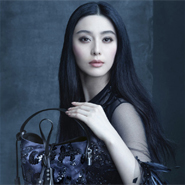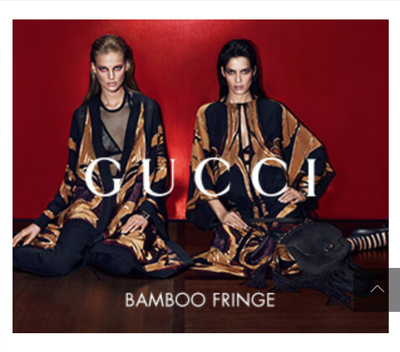 Louis Vuitton ad featuring actress Fan Bingbing
Louis Vuitton ad featuring actress Fan Bingbing
Contrary to the notion that big name fashion labels are losing their luster among Chinese consumers, a new study from ContactLab finds that Louis Vuitton is at the top of the list for brand awareness.
In a test of unprompted brand awareness, which measured the number of times that consumers in the study named the label’s name spontaneously, Louis Vuitton had twice as many mentions per 100 participants than its closest followers, Chanel and Gucci. Compared to more established luxury markets, such as New York, the Shanghai consumer is less sophisticated, not familiar with as many brands and more centered on mega brands.
"It’s clear that Louis Vuitton has a long lasting relationship with Asian market, China especially," said Stefano Lena, vice president of sales, ContactLab, Milan. "They have a clear and well-performing message around that area with a very clear positioning and pricing of the brand.
"There are other Italian and French brands that have the same level of attractiveness and awareness, even though they are not spontaneous top of mind," he said. "Maybe they are not present as Louis Vuitton, as a first response, but looking to the willingness of the customer, there are other brands that are emerging."
ContactLab and Exane BNP Paribas’ “China Reality Check: Luxury Consumers in Shanghai” study interviewed regular online users in New York and Shanghai between the ages of 25 and 54. Of the Shanghai respondents, 19 percent lived in the most upmarket area, and 80 percent of the total surveyed had purchased at least one luxury item in the past 12 months.
About face
These findings differ from the results of a Digital Luxury Group study last year, that found French label Chanel ranked as the most sought-after fashion brand in China, placing ahead of other brands such as Louis Vuitton, Dior and Gucci.
The second edition of the World Luxury Index China found that automotive is still the most searched luxury product category. Also, the data shows that Chinese consumers are changing their opinions on luxury fashion brands (see story).
 Gucci Bamboo fringe ad
Compared to Shanghai residents surveyed, New York respondents were aware of more brands, with Gucci, Coach and Louis Vuitton the most mentioned names in that order.
Even though they are not familiar with as many brands, Chinese consumers spend more on luxury goods than their U.S. counterparts at an equal income level.
Four out of five Shanghai residents have purchased at least one luxury item within the past 12 months, and most say they will be ready to purchase another luxury item within the next six months, according to a related report from ContactLab.
The study, which surveyed residents of both New York and Shanghai, found that residents of the Chinese city surveyed are also planning to outspend their New York counterparts for similar items by 66 percent when they buy their next luxury item. Seventy-seven percent of the New Yorkers surveyed say they plan to purchase in the next six months, compared to 91 percent of Shanghai respondents (see story).
Gucci Bamboo fringe ad
Compared to Shanghai residents surveyed, New York respondents were aware of more brands, with Gucci, Coach and Louis Vuitton the most mentioned names in that order.
Even though they are not familiar with as many brands, Chinese consumers spend more on luxury goods than their U.S. counterparts at an equal income level.
Four out of five Shanghai residents have purchased at least one luxury item within the past 12 months, and most say they will be ready to purchase another luxury item within the next six months, according to a related report from ContactLab.
The study, which surveyed residents of both New York and Shanghai, found that residents of the Chinese city surveyed are also planning to outspend their New York counterparts for similar items by 66 percent when they buy their next luxury item. Seventy-seven percent of the New Yorkers surveyed say they plan to purchase in the next six months, compared to 91 percent of Shanghai respondents (see story).
 Dior sign in Shanghai
Of those surveyed in Shanghai, 42 percent spent more than $1,000 on handbags in the past year, compared to the 11 percent of New Yorkers who said the same. Since luxury brands have an audience in Shanghai that spends on luxury fashion, it offers an opportunity for brands to raise awareness.
The Chinese consumer shopping habit of buying abroad is holding steady due to higher prices for goods at home. Only 30 percent of consumers said they bought all of their luxury goods in China.
Online multi-brand retailers are also a main source for luxury items for both New York and Shanghai respondents. Around 25 percent of Shanghai consumers shopped online, either on the brand’s direct operated Web site or a multi-brand online retailer for apparel in the past year.
Omnichannel importance
China’s online luxury sales jumped 71 percent between 2011 and 2012 and are projected to grow at double-digit rates for the next several years, according to a new report by Observer Solutions.
The report titled “Converging Trends: The Limitless Potential for Online Luxury in China” found that Chinese consumers are rapidly turning to the Internet for purchasing goods and services. In addition, the data suggests that the number of consumers making use of ecommerce platforms is expected to increase in the upcoming years (see story).
A new report by Boston Consulting Group explores the online shopping tendencies of Chinese consumers such as a widely-held penchant for researching products at length.
“The Chinese Digital Consumer in a Multichannel World” report explains that the number of Chinese online shoppers is expected to reach 380 million by 2016, which presents brands with huge swaths of potential customers. Any giddiness marketers feel at such a prospect should be tempered by the fact that only .5 percent of online activity is conducted on brand or company Web sites (see story).
Knowing that Chinese consumers use online channels heavily for research, brands can use that as an opportunity to educate consumers. Therefore, brands that do not fall high on the awareness scale have an audience open to suggestions.
"Because most of the Shanghai shoppers are omnichannel [brands looking to boost awareness] need to invest in connecting the dots between these channels with a consistent digital direct strategy," Mr. Lena said. "What we are doing is helping brands to sell a story around their brand, products and become top of mind for aspirational consumers.
"Deliver a very specific localized message closer to the Chinese culture with the right messaging for that market," he said. "Localizing the message, the communication and the image of the brand is also important.
"It’s important to link all the brand heritage with the Chinese touch and localize the communication, making it very specific for the country and for that customer. It’s absolutely mandatory to think how the Chinese interact with them, how they buy and what they want to get from a brand."
Final Take
Sarah Jones, editorial assistant on Luxury Daily, New York
Dior sign in Shanghai
Of those surveyed in Shanghai, 42 percent spent more than $1,000 on handbags in the past year, compared to the 11 percent of New Yorkers who said the same. Since luxury brands have an audience in Shanghai that spends on luxury fashion, it offers an opportunity for brands to raise awareness.
The Chinese consumer shopping habit of buying abroad is holding steady due to higher prices for goods at home. Only 30 percent of consumers said they bought all of their luxury goods in China.
Online multi-brand retailers are also a main source for luxury items for both New York and Shanghai respondents. Around 25 percent of Shanghai consumers shopped online, either on the brand’s direct operated Web site or a multi-brand online retailer for apparel in the past year.
Omnichannel importance
China’s online luxury sales jumped 71 percent between 2011 and 2012 and are projected to grow at double-digit rates for the next several years, according to a new report by Observer Solutions.
The report titled “Converging Trends: The Limitless Potential for Online Luxury in China” found that Chinese consumers are rapidly turning to the Internet for purchasing goods and services. In addition, the data suggests that the number of consumers making use of ecommerce platforms is expected to increase in the upcoming years (see story).
A new report by Boston Consulting Group explores the online shopping tendencies of Chinese consumers such as a widely-held penchant for researching products at length.
“The Chinese Digital Consumer in a Multichannel World” report explains that the number of Chinese online shoppers is expected to reach 380 million by 2016, which presents brands with huge swaths of potential customers. Any giddiness marketers feel at such a prospect should be tempered by the fact that only .5 percent of online activity is conducted on brand or company Web sites (see story).
Knowing that Chinese consumers use online channels heavily for research, brands can use that as an opportunity to educate consumers. Therefore, brands that do not fall high on the awareness scale have an audience open to suggestions.
"Because most of the Shanghai shoppers are omnichannel [brands looking to boost awareness] need to invest in connecting the dots between these channels with a consistent digital direct strategy," Mr. Lena said. "What we are doing is helping brands to sell a story around their brand, products and become top of mind for aspirational consumers.
"Deliver a very specific localized message closer to the Chinese culture with the right messaging for that market," he said. "Localizing the message, the communication and the image of the brand is also important.
"It’s important to link all the brand heritage with the Chinese touch and localize the communication, making it very specific for the country and for that customer. It’s absolutely mandatory to think how the Chinese interact with them, how they buy and what they want to get from a brand."
Final Take
Sarah Jones, editorial assistant on Luxury Daily, New York
